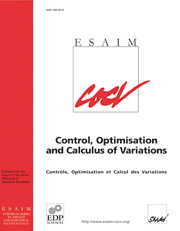Article contents
Mean-Field Optimal Control
Published online by Cambridge University Press: 08 August 2014
Abstract
We introduce the concept of mean-field optimal control which is the rigorous limit process connecting finite dimensional optimal control problems with ODE constraints modeling multi-agent interactions to an infinite dimensional optimal control problem with a constraint given by a PDE of Vlasov-type, governing the dynamics of the probability distribution of interacting agents. While in the classical mean-field theory one studies the behavior of a large number of small individuals freely interacting with each other, by simplifying the effect of all the other individuals on any given individual by a single averaged effect, we address the situation where the individuals are actually influenced also by an external policy maker, and we propagate its effect for the number N of individuals going to infinity. On the one hand, from a modeling point of view, we take into account also that the policy maker is constrained to act according to optimal strategies promoting its most parsimonious interaction with the group of individuals. This will be realized by considering cost functionals including L1-norm terms penalizing a broadly distributed control of the group, while promoting its sparsity. On the other hand, from the analysis point of view, and for the sake of generality, we consider broader classes of convex control penalizations. In order to develop this new concept of limit rigorously, we need to carefully combine the classical concept of mean-field limit, connecting the finite dimensional system of ODE describing the dynamics of each individual of the group to the PDE describing the dynamics of the respective probability distribution, with the well-known concept of Γ-convergence to show that optimal strategies for the finite dimensional problems converge to optimal strategies of the infinite dimensional problem.
Keywords
Information
- Type
- Research Article
- Information
- ESAIM: Control, Optimisation and Calculus of Variations , Volume 20 , Issue 4 , October 2014 , pp. 1123 - 1152
- Copyright
- © EDP Sciences, SMAI, 2014
References
- 101
- Cited by

